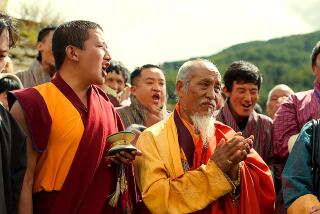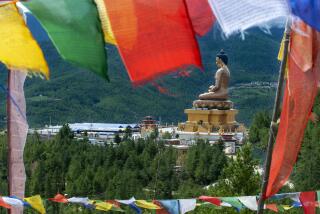A divine time in the kingdom
- Share via
Early in my trip to this tiny eastern Himalayan kingdom, I asked a crimson-robed monk at the ancient Kyichu Lhakhang Monastery in Paro whether I could roll his dice. I drew a lucky number, 12.
The monk assured me that my wish — to have a meaningful trip — would be granted.
He was right.
My husband, John, and I had come to Bhutan to attend the annual Paro Tsechu, a five-day festival honoring Guru Rinpoche, who brought Buddhism to Bhutan, and to get an in-depth look at this culture. We were among the lucky 9,000 or so tourists annually allowed into the landlocked country between India and Tibet. The way most tourists visit Bhutan is with a tour group, as we did in April. Once in, visitors are required to spend $200 to $240 per person, per day. Controlled tourism is just one way Bhutan protects its ancient culture and natural beauty.
Only five decades ago, the “Land of the Thunder Dragon” was isolated from the rest of the world, and its population depended on subsistence farming. The kingdom — at 18,150 square miles, about half the size of Indiana — had few schools and no telephones, national currency, hospital or postal service. Then, in the 1960s, Bhutan’s third hereditary ruler, King Jigme Dorji Wangchuck, took the first steps toward modernization, among them abolishing the caste system and slavery, and beginning a secular education system.
In 1972, his son, Jigme Singye Wangchuck, became king at age 16 and continued his father’s work, opening Bhutan’s borders to tourism — but with strict limits — to bring in much-needed revenue. His move paid off, improving the standard of living for the kingdom’s 2 million people while preserving its traditions.
Today, the Bhutanese enjoy a national healthcare system. Local TV programming began in the late 1990s, but it wasn’t until a few years later, when satellite TV arrived, that the world of the Bhutanese began to change rapidly.
“The Bhutanese have the best of both worlds, the traditional and the modern, although things are changing since the arrival of MTV,” said Chencho Dorji, a psychiatrist I met at one of the pre-festival celebrations in Paro.
Today, Bhutan may have many of the amenities of the 21st century, but its centuries-old customs and traditions still thrive.
*
Farmhouses like Alpine chalets
Our trip started in Paro, as our plane safely made the sharp, fast drop onto the runway. The pilots of Druk Air, the only airline with service to Bhutan, are experienced in clearing the high Himalayan peaks that surround the town and the country’s only international airport.Inside the terminal, decorated with intricate woodcarvings and bold primitive paintings, we met our guide, Tshering, then dropped our gear at the Hotel Olathang, a rustic place with an expansive view. After a lunch of locally grown red rice with emadatsi (cheese and hot chiles), Tshering took us on a tour of Paro.
The Paro Valley is chockablock with farms and farmhouses. They resemble Alpine chalets and are made of whitewashed stone and timber, topped with broad, sloping roofs. But Bhutan’s standout structures are the dzongs, ancient fortresses that serve as monasteries and administrative centers. Paro’s Rinpung Dzong, where we were headed, was the center of festival activities.
The dzong loomed above us as we crossed a small wooden bridge over the Paro River and walked uphill, feeling the 6,500-foot altitude.
Construction on Paro’s dominant landmark began in 1644, and not only is it one of the finest examples of Bhutanese architecture, it also is strong, having withstood many Tibetan invasions in its centuries of existence.
Locals streamed by us on their way to the first day of the tsechu, and I could feel their excitement as they passed. Tshering paused to wrap his 10-foot-long unbleached raw-silk scarf around his gho, the men’s traditional dress. Gho are long robes that men hitch up to knee length and belt tightly. The kira, which women wear, is a floor-length, rectangular piece of cotton or silk that is wrapped around the body, then affixed at the shoulders, tunic-like, over a silk blouse. All Bhutanese citizens are required to wear the national dress in public during daylight hours.
There are many festivals in Bhutan, and Paro’s is one of the biggest social gatherings of the year. Colorful stalls sell food, religious objects and hand-woven fabrics; others tout carnival games.
Each year, Paro’s monks and residents perform a 12-episode dance drama that commemorates the life of the country’s spiritual father. Guru Rinpoche, regarded as the second Buddha, spread Tibetan-style Tantric Buddhism throughout the Himalayas 1,200 years ago. Watching the tsechu’s ritual dances is believed to protect onlookers, to instruct them in the teachings of the Buddha and to exorcise evil influences.
Through it all, clowns, wearing long-nosed red masks, weaved in and out of the scene, acting as masters of ceremonies, performing between the dances, chasing dogs and children off the staging area, and teasing tourists and locals.
On the festival’s final day, we arrived in the predawn hours at the dzong for the annual unfurling of the giant thondrol, an embroidered tapestry of depicting Guru Rinpoche, which cannot see the light of day. The Bhutanese believe that looking at the icon washes away their sins.
One of the festival attractions was an archery concession — archery is close to an obsession here — and John paid a few coins to try hitting a Bhutanese bulls’-eye. He hit the target a couple of times, to the amazement of watching locals.
Later, John asked our driver to stop for a while at an archery field on the outskirts of Thimphu, Bhutan’s capital. Competitors in the friendly Sunday match had set their wooden targets 500 feet away. When an archer hit the mark, his teammates lined up and danced with joy.
Thimphu, a winding two-hour drive from Paro, is the country’s only real urban settlement. A few years ago, a stoplight was installed at the city’s downtown traffic circle. When residents complained that they preferred a traffic cop, the local administration complied.
As we headed east from Thimphu, Tshering warned us that the snow-capped Himalayas are seldom visible from the 10,000-foot mountain pass at Dochu La on our way to Bumthang. Thunderstorms and torrential rains are common here, and the average rainfall is more than 200 inches in the south. But that day our luck held, and we were greeted with the sight of mountains gleaming in the sunlight.
Bumthang is the base for visiting the pastoral Tang, Choekhar, Chumey and Ura valleys. Guru Rinpoche converted the region to Buddhism in the 8th century and it remains the country’s most religious. At Choekhar Valley’s 500-year-old Tamshing Goemba Monastery, we saw 6- to 8-year-old monks enthusiastically reciting prayers in unison.
As we left the Ura Valley, Tshering spotted a convoy of official vehicles carrying the country’s head abbot, Je Khenpo. In a wild ride, our driver sped past them as the abbot stopped to bestow blessings on some residents standing beside the road.
When the convoy caught up to us, the lead policeman turned on his car’s siren and lights, signaling us to pull over so that he could pass. Our driver instead stopped in front of a simple farmhouse, where a mother was holding a child. We jumped out, lined up next to her, and bowed our heads so that the abbot could pray over each of us.
“You are now blessed,” the policeman said emphatically.
After having visited Bhutan, I know he was right.
*
(BEGIN TEXT OF INFOBOX)
A spiritual journey
GETTING THERE:
From LAX, Thai Airways flies direct (one stop, no change of planes) to Bangkok. JAL, China Airlines, ANA, Northwest, Korean, China Eastern and United have connecting flights (stop, change of planes). Restricted round-trip fares begin at $730.
From Bangkok, the only option to Paro, Bhutan, is Druk Airlines. Restricted round-trip fares begin at $740.
TELEPHONES:
To call the numbers below from the U.S., dial 011 (the international dialing code), 975 (the country code for Bhutan) and the local number.
PACKAGES:
Visitors must book a prepaid, guided package tour or a custom tour through a registered tour operator in Bhutan or affiliated companies abroad.
Bhutan Tourism Corp., P.O. Box 159, Thimphu; 2-324045, fax 2-323392, https://www.kingdomofbhutan.com .
Far Fung Places, 1914 Fell St., San Francisco, CA 94117; (800) 410-9811, https://www.farfungplaces.com . Our arrangements were made by this company, the U.S. marketing representative of the Bhutan Tourism Corp. An 11-night package costs $3,720 per person, double occupancy; $4,100 for 13 nights. Tours include flights between Paro and Bangkok (but not airfare to Bangkok), all lodgings, meals and transport in Bhutan.
WHERE TO EAT:
Meals, usually buffets served in guesthouses, include Western and Bhutanese dishes.
WHERE TO STAY:
Amankora, Paro; 011-65-6887-3337 (central reservations line in Singapore), https://www.amanresorts.com . A luxury resort, part of the Aman Resorts chain. Doubles $900, plus $289 in taxes and service charges.
Uma Paro, 8-271597, https://www.uma.como.bz . One of the Hong Kong-based Como Hotels and Resorts. Doubles $280-$1,200.
TO LEARN MORE:
Department of Tourism, Bhutan, P.O. Box 126, Thimphu, Bhutan; 2-323251, fax 2-323695, https://www.tourism.gov.bt .
— Mary Altier
More to Read
Sign up for The Wild
We’ll help you find the best places to hike, bike and run, as well as the perfect silent spots for meditation and yoga.
You may occasionally receive promotional content from the Los Angeles Times.






